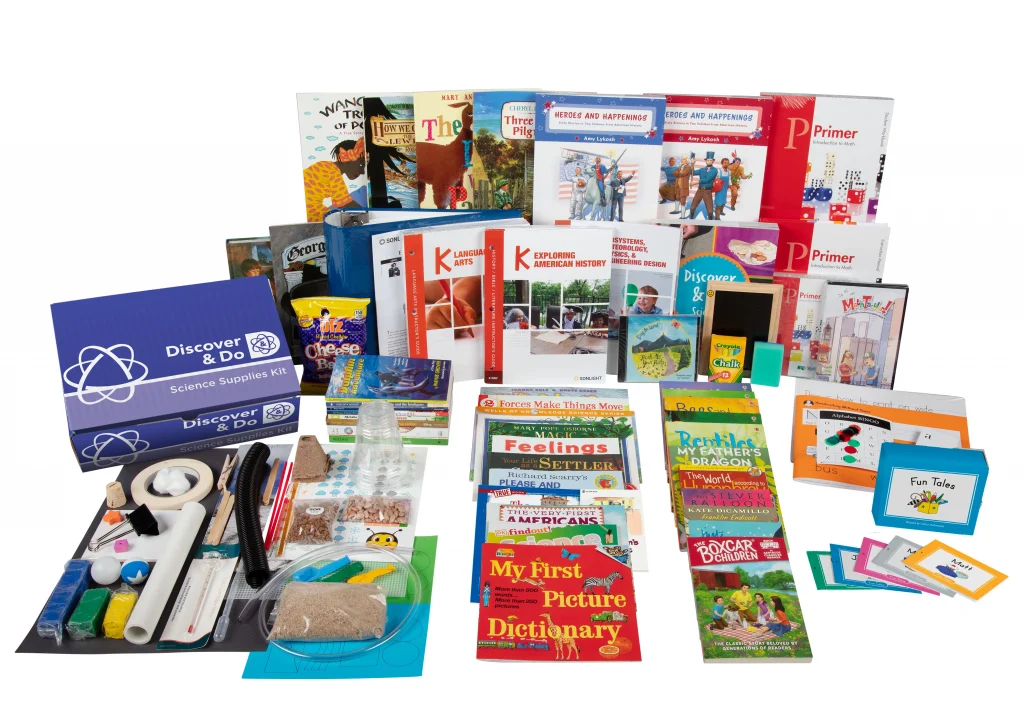My son was struggling in math. We had been homeschooling for one whole year, and I could already see that he hated math. The curriculum we had been using was mostly workbook based and there were a lot of problems for each lesson. My son, who has dysgraphia, already hated picking up a pencil, and the added stress of an entire page of problems was more than he could bear. Tears flowed more and more often the further we got into the year. I tried marking out all the odd or even problems, but it didn’t help. He hated it, and he had prematurely decided that he was not good at math.
I knew I had to change something, but everything that I found seemed to be more of the same—more workbooks, more endless pages of problems. I knew that would never work. What would be the best homeschool math curriculum for him?
Then, I stumbled on a curriculum called RightStart Math. It was very light on pencil work but heavy on mental math and hands-on activities. I thought it just might work.
And it did!
Not only did it work, but my son went from hating math to believing he might be a math prodigy! It was such a relief to this mama’s worried heart. Seeing such a visible change right before my eyes was one of my greatest homeschool memories. I had been able to give him what he needed to soar. And it felt so good.
When I find something I love, I tell everyone I know, and I love Sonlight and RightStart Math. So when I found out that RightStart Math was going to be a math option for Sonlighters, I rejoiced!
Here is why we love RightStart Math curriculum. It's great for all kids, of course, but it really turned around my math hater's poor opinion of math.
1. RightStart Math is Hands-On
RightStart Math is a very hands-on math program. I think this was the selling point for my son. He was used to math being a pencil and paper time of the day, which caused him to dread it. So the first day when I pulled out the AL Abacus and no paper, he was pleasantly surprised.
When we played a card game, and I said, “Okay, we are finished with our math lesson today,” he was sold. Every lesson has an optional game which is a fantastic tool for teaching and reinforcing the concepts presented in the lessons. Later on, when worksheets began to show up in the lessons, he was not overwhelmed. It was just enough practice to do the job. No more, no less.
The manipulative kit that comes with the set is invaluable and you will end up using every piece in the set because almost every lesson in the book involves a manipulative of some sort. My kids have always enjoyed using the manipulative set even for fun outside of school hours.
2. RightStart Math is Visual
RightStart Math is a very visual program. In fact, the early lessons instruct you to be sure your child can show the number 5 on the AL Abacus without counting. The idea here is for the child to be able to see how and why math works. Another favorite tool of mine is the math balance which helps kids visualize the way equations balance. We have used it far beyond the early elementary years!
3. RightStart Math Has Heavy Emphasis on Mental Math
RightStart Math is heavily focused on mental math. Each lesson has a warm-up that consists of a handful of mental math problems. I was amazed to see how proficient my kids were at these little quizzes as time went on.
Remember my son who hated math? He quickly realized that he may not shine so brightly when it comes to writing out problems, but he glows with mental math. This math transformation made me a raving RightStart Math fan! Within a few years of starting RightStart Math, he was doing multi-digit multiplication and long division in his head.
4. RightStart Math is Logical
I’ll be honest, at first I had my reservations about how RightStart Math progresses. At times I was surprised by the order the concepts were taught—radically different from what and how I learned in grade school. But, I trusted the curriculum, and I quickly realized that it was actually a more logical way to learn the math! In fact, I wondered why I had never thought of presenting math in the progression that RightStart uses.
5. RightStart Math is Light on Paperwork
I’ve always struggled with giving my kids a seemingly endless page of math problems to do. When I saw that RightStart Math was light on the paperwork, I was so happy. Gone were the days of crying during math, and none of us missed those days at all! Don’t be concerned. There are work pages and tests, but the work pages are the perfect amount of practice. There is no busy work to be found anywhere in this curriculum.
Review is mostly oral at the beginning of each lesson, so you never have to worry about your children forgetting what they’ve learned. The tests are reasonable yet thorough. That brevity makes math more pleasant for my children, but it also helps me. It’s a cinch when I go to check my children’s work. I usually am able to take care of that task in just a few minutes, and my kids have automatic feedback on what they missed. Since they aren’t already burned out on math, they are willing to carefully correct their mistake.
6. RightStart Math Provides Family Time
Yes, I’m being totally serious. We love RightStart Math because it has provided us with tons of quality family time. The only complaint I’ve ever heard about RightStart Math is that it can be teacher intensive, and I suppose that is true to an extent. It does require the parent to go through the lesson with the child, but I would offer a different perspective. For my family, RightStart Math encouraged us to spend time together.
We spent hours each week drawing with the T-square and using the math balance. I found the lessons as interesting as my kids did. After lessons, we would all get together and play the card games. Most of the games can be played by just about any age, so math time quickly morphed into family game time. Instead of pulling out board games, my kids would grab the Basic Number card set and we would play math games. For them, it was just playing games with the family. For me, it was quality time with the added benefit of math practice. I cherish the time we’ve spent drawing geometric figures and learning new ways of thinking about numbers together. I’m thankful that RightStart Math gave me just that.
All my children have used RightStart Math now, and every one of them has reaped the benefits of this outstanding math curriculum. I recommend RightStart Math to every homeschool mom I meet because I believe that it is that good. So if your child struggles as a math hater, maybe RightStart Math would be a good fit for you like it was for us.
To find out more about Sonlight's book-based programs and math options, order a complimentary copy of your catalog today.













